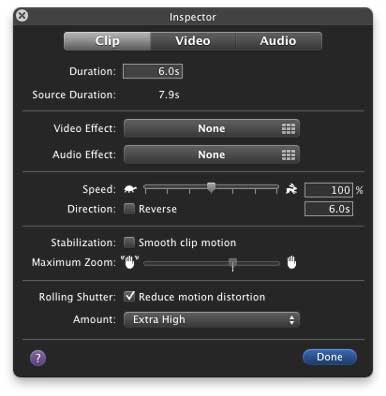Rolling Shutter fix in iMovie ’11 The feature Final Cut Pro users have been waiting for?
You’ve probably heard about the amazing-wonderful-phenomenal Apple “Back to the Mac” event that took place on October 21st. At first sight, it was a rather insignificant event for us professional filmmakers, with a preview of the new Mac OS X Lion (which is taking a lot of its new features from iOS), some new MacBook Airs and the introduction of iLife ’11.

Part of the iLife ’11 package is of course iMovie ’11, a revamped version of Apple’s amateur movie editing tool. I really don’t want to talk iMovie down – it’s amazing how they are able to include more and more complex editing functions in such a little and easy-to-use programme, and one of the first editing programmes I used was iMovie 1.0 on my iMac DV Special Edition, still running on the awful Mac OS 9. It is however frustrating to be a professional Mac user these days as Apple makes more and more money with their iPhones, iPads & iDontknowwhat, while neglecting development on an ever-aging Final Cut Studio suite (the last update was a joke). But enough on that, don’t get me started!!
Anyway, you might be wondering why I’m talking about iMovie here, which is by no means a professional programme. To make a long story short, they introduced great features that would make a hell of a lot of sense in Final Cut Studio too. I’ll just talk about these two features, although there is much more to the new version (but the rest is mostly irrelevant for pro’s, though the automatic movie trailer edit presets might be fun as a joke).
First off, there’s the People Finder, which identifies clips that contain people. That might not sound like a big deal, but having something like that would seriously help save time when logging and organizing clips before you actually start to edit – and pre-selecting clips in a huge project is the work I really don’t like to do.
People Finder doesn’t stop there, though – iMovie is obviously able to differentiate between full shots, medium shots and close-ups, and THAT is seriously a massive time-safer. As you certainly know, especially in narrative projects, the same scenes are often shot in different shot sizes to give the editor and director more choices in post-production. Organizing this stuff is a huge pain to me and having an auto-shot-size-selector would save even more time than a People Finder.
Check out this demo of iMovie ’11 and features like People Finder during the “Back to the Mac” special event – jump to 00:29:39 to go directly to the iMovie ’11 introduction!
Yeah, I finally get to the point of the post (sorry, I always save the best for last!), which is apparently a rolling shutter fix for footage that was acquired with cameras sporting a CMOS sensor (that means virtually all modern video camcorders and especially all the DSLRs – check out my blog post on the problems with DSLRs for a definition of “rolling shutter” aka “skew” aka “CMOS wobble”). I have demonstrated the rolling shutter effect of the Canon T2i/550D in an – admittedly extreme – clip:
The rolling shutter fix apparently is a purely mathematical solution for this problem and doesn’t need to re-analyze the footage. Therefore the results vary depending on the kind of footage. I haven’t tried it yet, but will do so shortly and will try to correct the T2i/550D rolling shutter clip from above.

There is a software plugin from The Foundry that does a great job of reducing rolling shutter / skew very efficiently (using After Effects or Nuke), but it’s $500 and therefore clearly way out of budget for many DSLR shooters.
Be sure to check out Macworld’s review of iMovie ’11, they already posted this clip with some uncorrected footage suffering from the rolling shutter effect, followed by the corrected version. It sure looks good to me!
I’ll post an update to this blog once I’ve tried it myself. I know there are reports of many bugs with iLife ’11, but as usual, Apple will eliminate those within weeks. If it works like it’s supposed to, the rolling shutter fix alone is worth using iMovie to correct all clips suffering from this problem and re-importing them in Final Cut Pro afterwards!!
For now, I can only say once again: Apple, PLEASE give us a noteworthy update of Final Cut Pro!! I still love it, but it still has tons of bugs (many of them since version 1.2.5), annoying render and file management, and it misses out on so many great features that the competition like Adobe’s Premiere is very quick to implement … introducing a rolling shutter fix in Final Cut Pro would be a GREAT start to improve the software.
UPDATE October 31st, 2010:
I tried the rolling shutter fix with an old shot done with my T2i/550D (check out the original post here, I posted it as part of the T2i/550D review), and it worked out well:
Philip Bloom tested the Rolling Shutter Fix in iMovie ’11 after I pointed it out to him, here is a little tutorial video with a comparison between the unprocessed and the processed images without the rolling shutter effect:
-
Great post. Thanks for the info. I have imovie 11…i really should try it out!
-
Nice info Nino, def. wil give iMovie a shot!
Rolling shutter issues are major concern from now on, our tests with the Canon XF300 also gave us some thoughts.Sometimes its almost impossible to just not get.
-
Loved your post, we rly need better tools in a Final pro and would be great to strat with this insane issue that dslr have.
didnt get why apple is investing in a simple edit tool on other hand its a start.Keep going the nice work bro.
-
There’s an excellent free plug-in for VirtualDub (ie for Windows) that fixes both rolling shutter problems and camera shake. A bit harder to implement in the normal workflow but compared to 500 dollars it’s a steal.
-
A quick tip for you
if you want to get people to check out a specific time in a youtube video – there is a timecode tag you can add at the end.
For instance to get it to start at 29mins 39 seconds as you said in your blog add #t=29m39s to the end of the address – sampled below!http://www.youtube.com/watch?v=SHllK_hKFxY#t=29m39s
btw – great blog – I’ll be checking back for sure!
-
This is thrilling!! Hope Apple would realllllly do things right this time!!
-
Thanks for the post. Will be interesting, what Apple’s strategy looks like. Hope they do something very quickly, I think many filmmakers are nor satisfied with the Suite any more.
-
i had a play with this last night and it works well. Really liking some of the features of iMovie11 and like you, really wishing some of these came to FCP.
Thanks for bringing it to my attention. Shall put something online when I get a chance to show it working
-
Is the suggestion/revelation being offered here: that Apple somehow has the ability to correct ‘rolling shutter’ in iMovie but NOT in FCP?
Dan
-
Can the footage suffering from rolling shutter be corrected in iMovie ’11 and then imported into FCP?
-
Nice find!
Yes, I agree with you that it is frustrating that innovative fixes like this are appearing in Apple’s consumer apps, instead of the long forgotten pro apps. But then, for iMovie, this is no different, take for example:iMovie could render in the background and let you continue working while it rendered, from version 1, in OS-9, on a 400 MHz G4. (Something FCP still can’t do on a 12-core machine!)
iMovie could record a VO to the timeline while playing back the timeline, from version 1, in OS-9, on a 400 MHz G4.
iMovie arranges all your media for each of your projects in dedicated project folders that it manages properly, so newly captured media goes in the folder for the project you are working on now, not some preference you set last week, like FCP does.
iMovie handled MP4 video from still cameras before FCP.
And now iMovie corrects CMOS skew. FCP doesn’t.
I think it’s clear, like you say, that Apple’s “focus” is clearly not on anything professional. One desktop machine. Forgotten apps. Ignoring Blu-ray. Etc.
But I disagree about OS-9. Even on the last tower that supported it, we stayed in OS-9 as long as possible because (like OS-X) when properly managed, it’s rock solid. Moreover, the footprint was a lot smaller (60 MB of RAM) and it was wicked fast. Jumping back and forth between the OSes on the same machine really showed me how much of a dog OS-X is- and it continues to get pudgier as it grows. Even with a Core 2 Duo laptop, there’s still that slight delay every time I open a menu. I never had that, even on my G3 machines in OS-9. That’s why Pro’s need 12 cores, just for OS-X to _appear_ like it’s not a dog. 🙂
-
I watched Bloom’s comparison video and it actually looks like, at the end of the whip pans, iMovie OVERCORRECTS and the buildings and the bridge lean the opposite way. I thought I saw something a little wonky in normal viewing and careful pausing confirmed this.
But, in real life, there’s seldom back and forth whippans and I expect iMovie to handle normal pans just fine.
Can someone test it for vertical jello (compression, decompression)
I doubt it corrects multi-frame flash strobe effects. -
well done Nino great post. will have to give that a try.
-
I shot a music video on two 5D’s and hired The Foundry’s Rolling Shutter for a few days during post. At first the results seemed great, but when I looked closer, the artifacting was too much; footage broke up and distorted.
This was for trains going past, whip pans and moving the camera about without a tripod.
Can anyone comment on the difference between this program and iMovie’s Rolling Shutter capability? Would I be able to process that effect on Pro Res HQ footage?
-
I have access to FCP and I’m about the get a new MacBookPro as need to upgrade from MacBook. But I see no need to purchase FCP just yet as iMovie is capable enough to facilitate basic professional work using stills, audio and video together. I’m looking forward to better audio syncing with version 11.
-
Hi guys, apparently there is a plugin for Final Cut Pro available these days. It’s called Lock & Load X by CoreMelt. Here’s a link: http://www.coremelt.com/products/lock-and-load-x.html
I’m trying to get a wobble removed from Hero Gopro HD footage, shot from a hexakopter, but so far I’m not too thrilled with the results. Perhaps some wrong settings? Anyone else willing to give it a try? It’s got a 15 day trial period.
-
Thank you for that info there and lil demo.
I also think the inclusion of the Apple promo was very useful as well.
I am a very new convert to Mac as such still finding my way around, I like iMovie very much it is indeed very easy to use i was editing video with 4 hours of the Mac being out the box. I envisage lots of fun working with it.
Thanks again for your information on Rolling Shutter.
-
After many of the updates, FCPX is now significantly better.






















Comments